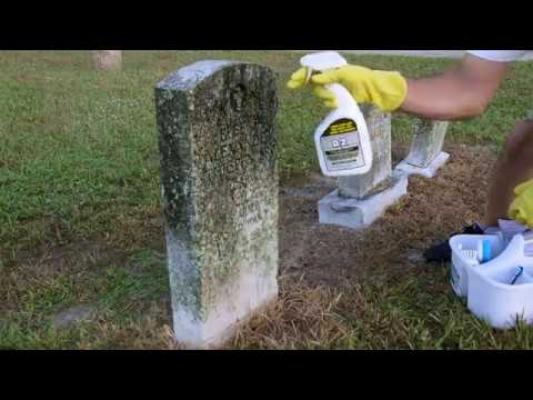The surface of a headstone can unduly be covered in dirt, lichen, moss, algae, tree sap, mildew, bird droppings, and pollution as time goes on. It is possible to visit a loved one’s gravesite more pleasant by keeping it tidy and well-maintained.
If you’re interested in historical documentation or just want to make a cemetery more beautiful, it’s important to know what you’re doing and use safe procedures to avoid harming the graves. It is important to ensure that a tombstone is not in any way unstable before washing it.
Give the stone a little tap. One possible cause of a hollow sound is delamination, which occurs when the stone’s layers separate. It is not safe to clean anything that has significant damage, such as cracks, loose parts, or holes.
After that, cut back any overgrown plants. Carefully remove any vegetation from your headstone without damaging it. It may be necessary to prune ivy and other similar plants every six inches and at the base. Give it time to die after a trim before removing and washing it if you want thicker growth. Keep your gravesite free of vegetation by weeding and maintaining it regularly.
Methods For Cleaning Granite Monuments:

The various kinds of headstones found in cemeteries are highly diverse. You can find a wide variety of crosses here, from ancient wooden ones to more contemporary monuments. Grave markers crafted from granite will be the focus of my examination in this section.
Removing Mildew From Granite Monuments:

- Mold, that monstrous green monster, has finally met its match.
- To begin, gather some water and a soft-bristle brush (I beg you not to use a wire brush; they are useless). Carefully, but gently, scrub the granite headstone’s surface without rubbing it too hard.
- In a spray bottle, combine 1 part bleach with 4 parts water. (Prioritizing safety, be sure to wear protective gear such as gloves and goggles.) After spraying the stone liberally, give it around 15 minutes to soak in the mixture.
- If you’re feeling adventurous, now would be a great time to take a stroll around the cemetery.
- Rinse the stone with water after your stroll among the sadly dead. Et voilà! You should no longer be bothered by the mold.
How To Remove Grime And Mildew From Granite Headstones:

We will remove this inconsiderate creature from your priceless granite gravestone.
Get Out All Your Cleaning Supplies:
Begin by following the label directions on the non-ionic cleaning you may find at your preferred tombstone-care supplies store. Mix the cleanser with clean water. Your great-great-grandmother would be upset if you slacked off on this step.
Get out your soft-bristle brush and delicately scrub the region that is covered in lichen. Keep in mind that you are attempting a delicate touch, not an aggressive one.
Granite Gravestone Sealing Instructions:
- You have become an expert at washing granite headstones at this point.
- You must first allow the stone to dry entirely. We don’t want any annoying water to be trapped when we seal, therefore yes, we do mean it.
- After it dries, get a clean towel and a high-quality granite sealer; the cemetery caretaker in your area may be able to suggest suppliers. Spread the sealer evenly over the surface and apply it per the bottle’s directions.
- After the suggested drying period, use a clean, dry cloth to give the sealer one last polish. Get a good look at what you’ve accomplished.
- That is the proper way to polish and seal a granite headstone, my esteemed tombstone enthusiasts. Give yourself a pat on the back; you’ve just become an expert in removing mold, lichen, and sealing granite.
White Marble Headstone Cleaning Instructions:

Beautiful and graceful as they are, white marble headstones attract dirt and dust like a magnet. Rest assured, my fellow marble enthusiasts, we possess the secret formula for triumph.
- First things first: stay away from acidic cleaning products at all costs. No seriously, if you care about your connection to the dead, you should never use such cleaning products on your marble gravestone.
- Choose a mild, biodegradable soap or a non-ionic cleaning instead. Ancestors will be eternally grateful.
- Following the directions on the label, combine the cleaner of your choice with water. Scrub the stone carefully, being careful to get into all of the crevices, using a soft-bristle brush.
Methods For Sanitising Black Marble Monuments:

Black marble grave markers were a symbol of refinement, but also a surface for pollen and bird droppings. Rest assured, though; we possess the magic formula that will return them to their illustrious past.
- Acidic cleansers will ruin them, just as they would white ones. You should instead use the mild biodegradable soap or non-ionic cleanser that you prefer.
- Believe me when I say that your black marble tombstone will be forever appreciated.
- Allow your soft-bristle brush to do its job after you mix the cleaning solution with water according to the directions on the label. Do not scrub too vigorously; we are going for a gentle touch.
- Because of its fragility, handle the stone with care befitting a priceless work of art.
- Rinse the black marble headstone well with water after you’ve given it the royal treatment. Look at this stone; it’s just as modern and chic as when it was first revealed.
- And there is the whole, glorious story of polishing a marble headstone, folks. You have elegantly and thoroughly cleaned both white and black marble grave markers, removing all traces of dirt and grime.
Utilize A Cleaning Kit For Bronze Grave Markers:
Having the correct equipment is half the battle when it comes to cleaning bronze headstones. And that’s the situation that a premium bronze grave monument cleaning kit solves.
You might wonder, though, what exactly makes a bronze cleaning kit the best. Keep an eye out for these crucial elements:
- A non-abrasive, mild cleaning solution made especially for bronze. This is the foundation of any decent cleaning kit, and it will assist you in regaining the desired patina without doing any harm.
- A gentle bristle brush ideal for intense cleaning sessions. Recall that we are stroking the stone rather than striking it.
- A polishing cloth to polish the bronze after cleaning it to a high sheen. Your forefathers would be pleased.
- Wear protective gloves and goggles because your safety comes first.
FAQs:
How Should A Gravestone Be Cleaned?
Be cautious while cleaning or brightening gravestone surfaces because many gravestone surfaces, such as granite, marble, sandstone, slate, etc., are porous and delicate. This fragility also adds to their attractiveness. It’s acceptable to lightly mist the inscription to make it stand out more or to make it cleaner.
Can You Clean Headstones At Home?
An alternative to cleaning solutions that are unsafe to use on granite or other porous rock types is homemade headstone cleanser. Because a natural tombstone cleanser is composed of common household materials safe for the stone and the environment, it is kinder to headstones.
Does Cleaning A Headstone Require Access To Water?
You won’t likely have access to a hose or water source while in the cemetery, so you’ll need to bring your water supply. Bring extra water if you’re washing a companion headstone or family plot, and at least five gallons if you’re cleaning a headstone of average size.
Conclusion:
Avoid using cleaning solutions too frequently. Over time, the stone may erode due to cleaning agents and scrubbing force. Tiny particles are removed from the stone with each cleaning, therefore doing so too frequently or using the wrong methods might be detrimental.
Slate, sandstone, and marble stones should only be cleaned once every seven to ten years due to their faster rate of deterioration. Every three months, bronze markers can be cleaned. However, despite your best efforts, cleaning will not eliminate the blue-green patina that bronze will eventually acquire.

